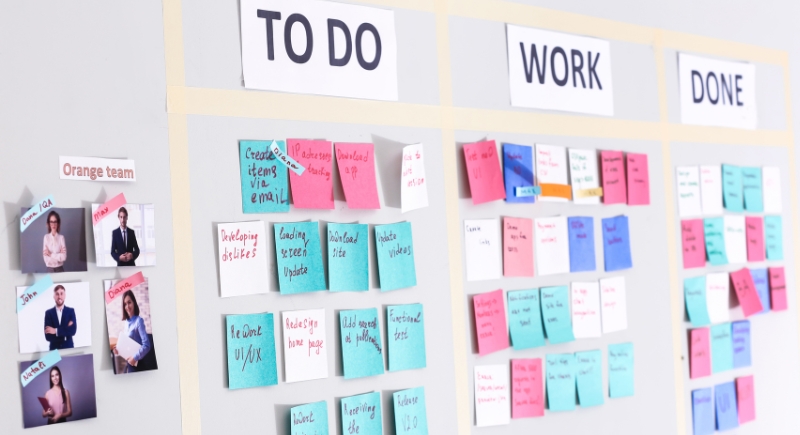15 Fast Fixes to Help You Stop Drowning in Tasks
Most of us have had days when our list of tasks feels endless. The more we try to tackle everything, the less we seem to accomplish. You don’t need a dramatic fix to turn things around. A few clear adjustments can help you regain focus and make steady progress, even when your workload seems heavy.
Shrink Your List to What Actually Matters

Credit: Canva
Behavioral scientists suggest trimming your list by asking: will something bad happen if this doesn’t get done? If the answer’s no, cut it. That mental edit helps quiet the noise and gives you a smaller, more manageable list you can actually finish without spiraling into guilt or decision fatigue.
Use a Timer

Credit: Canva
The Pomodoro Technique—25 minutes of focused work, followed by a five-minute break—keeps the brain sharp and the pace realistic. Humans are notoriously bad at estimating time, so this method gives a clearer idea of how long things take.
Block Out Noise

Credit: Canva
Distractions waste time and drain focus. A 2023 study from the University of California found it takes an average of 23 minutes to refocus after an interruption. Use noise-canceling headphones, turn off notifications, and mark yourself as “busy” in apps when needed.
Write It All Down, Then Cross It Out

Credit: Canva
Getting tasks out of your head and onto paper gives clarity, but don’t just stop there. Crossing off completed items has been shown to give the brain a dopamine boost. That little hit of satisfaction keeps the momentum going. Bonus: When your mind isn’t juggling reminders, it focuses on the work.
Say No And Mean It

Credit: Getty Images
Overwhelm often starts with too many yeses. Studies show people who protect their time by setting boundaries report higher job satisfaction and lower stress. Practice saying, “I can’t take that on right now,” without explaining your life story. A clear no saves hours later.
Give Worry a Scheduled Time Slot

Credit: Getty Images
Psychologists like Nick Hatter suggest scheduling 10–15 minutes of “constructive worrying” each day. Jot down what’s bugging you, then brainstorm a plan or write “if-then” solutions (if X happens, I’ll do Y). It turns out that anxiety respects a calendar even when you give it a fixed home.
Let Nature Reset Your Brain

Credit: Getty Images
A quick break outdoors can do more than clear your head. Just ten minutes in fresh air has been shown to lower stress and improve memory. You don’t need a trail or a park; a few minutes on a porch or near a window can work. Even brief sunlight reminds you there’s more to the day than a screen or a to-do list.
Focus On One Task Until It’s Done

Credit: Getty Images
Multitasking feels efficient, but it destroys productivity. Researchers at the American Psychological Association found that task-switching lowers efficiency by up to 40%. So if you’ve got five half-finished projects, pick one and finish it completely. Then move to the next.
Reorder Your Day Around Your Energy

Credit: pixelshot
If you’re more focused at 10 a.m. than 3 p.m., plan your hardest tasks for that window. Everyone has natural productivity peaks—research calls them “chronotypes.” Ignoring yours leads to sluggish, drawn-out work. Save emails and admin tasks for your slump hours, and use your peak time for deeper focus.
Ask For Help Without the Guilt

Credit: Getty Images
If you’re feeling buried, let someone know. People are far more willing to help than we assume. Ask a coworker to split a task or ask your manager to help re-prioritize. You don’t have to struggle silently to prove anything.
Check Your Shoulders, Jaw, and Hands

Credit: Getty Images
Stress shows up physically before you might even notice it mentally. Tight shoulders, a stiff jaw, or restless hands often mean your body is carrying more than it should. When you catch these early, simple actions like stretching or taking a few deep breaths can bring your focus back and help you reset.
Lie Face Down on the Floor

Credit: iStockphotos
When the spiral starts, lying face down on a firm floor can help interrupt it. This oddly effective method brings awareness to physical sensations—coolness, pressure, stillness—rather than racing thoughts. Some people start mentally triaging their to-do list while down there.
Go Small. Then Smaller

Credit: pixabay
If a project feels too big, break it down until the first step is something you can do right now. Instead of aiming to finish a report, try writing a single line or just opening the document. Even a small start builds momentum and can help you move forward. This method is called behavioral activation, and it works for more than just work tasks.
Laugh at Something, On Purpose

Credit: Getty Images
A 30-second chuckle can short-circuit stress and help you reset your approach to the day. Laughter reduces stress hormones like cortisol and increases endorphins. Watch a silly video, text a friend who cracks you up, or read the comments section of a wholesome meme account.
Breathe Like It’s a Button

Credit: Getty Images
Neuroscientists have shown that slow, controlled breathing (especially the “box” method: inhale 4, hold 4, exhale 4, hold 4) slows your heart rate and tells your brain it’s safe. It’s free and surprisingly effective at stopping a full-on overwhelm spiral.